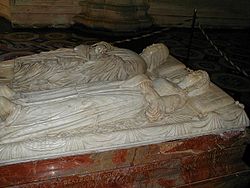
Cristoforo Solari
Encyclopedia

Cristoforo Solari also known as il Gobbo (the hunchbacked), was an Italian
Italy
Italy , officially the Italian Republic languages]] under the European Charter for Regional or Minority Languages. In each of these, Italy's official name is as follows:;;;;;;;;), is a unitary parliamentary republic in South-Central Europe. To the north it borders France, Switzerland, Austria and...
sculptor
Sculpture
Sculpture is three-dimensional artwork created by shaping or combining hard materials—typically stone such as marble—or metal, glass, or wood. Softer materials can also be used, such as clay, textiles, plastics, polymers and softer metals...
and architect
Architect
An architect is a person trained in the planning, design and oversight of the construction of buildings. To practice architecture means to offer or render services in connection with the design and construction of a building, or group of buildings and the space within the site surrounding the...
. He was the brother of the painter Andrea Solari
Andrea Solari
Andrea Solari was an Italian Renaissance painter. He was initially named Andre del Gobbo, but more confusingly as Andrea del Bartolo...
.
Among his work, one of the most famous is the tomb
Tomb
A tomb is a repository for the remains of the dead. It is generally any structurally enclosed interment space or burial chamber, of varying sizes...
of the dukes
Dukes
-Albums:-EPs:-Singles:...
Ludovico il Moro and Beatrice d'Este
Beatrice d'Este
Beatrice d'Este , duchess of Milan, one of the most beautiful and accomplished princesses of the Italian Renaissance, was the daughter of Ercole I d'Este and younger sister of Isabella d'Este and Alfonso d'Este....
for the Certosa di Pavia
Certosa di Pavia
The Certosa di Pavia Gra-Car , Shrine of the Blessed Virgin Mary Mother of Grace, is a monastery and complex in Lombardy, northern Italy, situated near a small town of the same name in the Province of Pavia, 8 km north of Pavia...
, carved between 1497 and 1499.
For a while people thought he had sculpted the Pietà, causing Michelangelo to break into the church and chisel his name on it.

